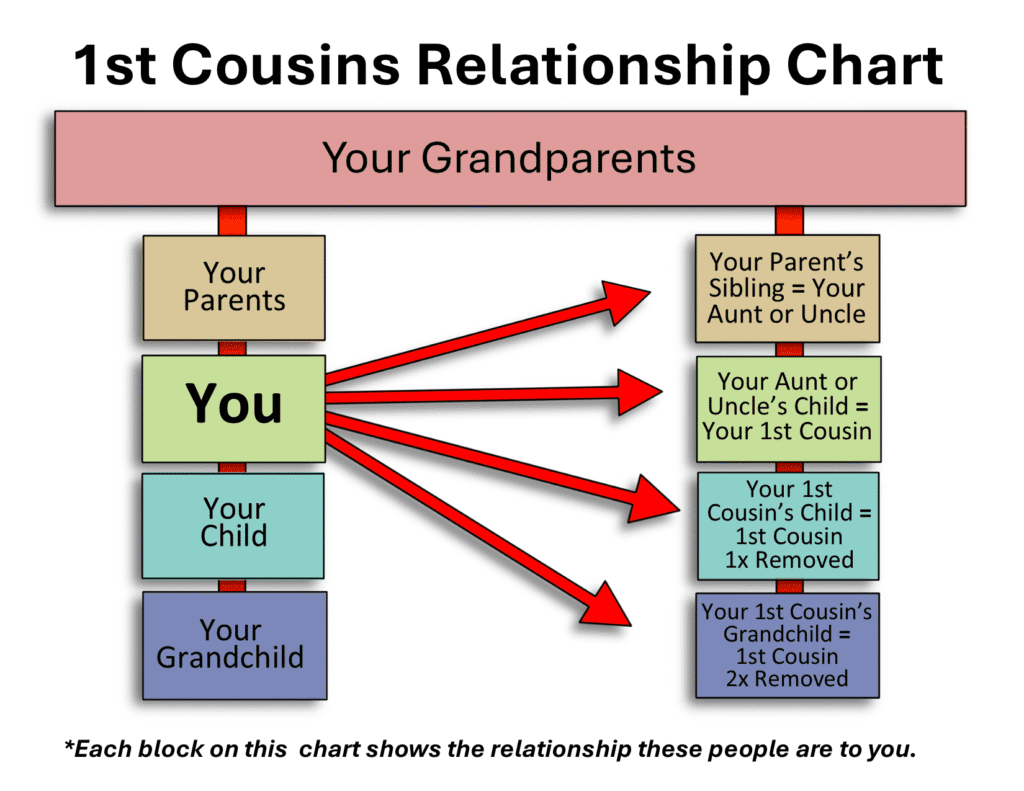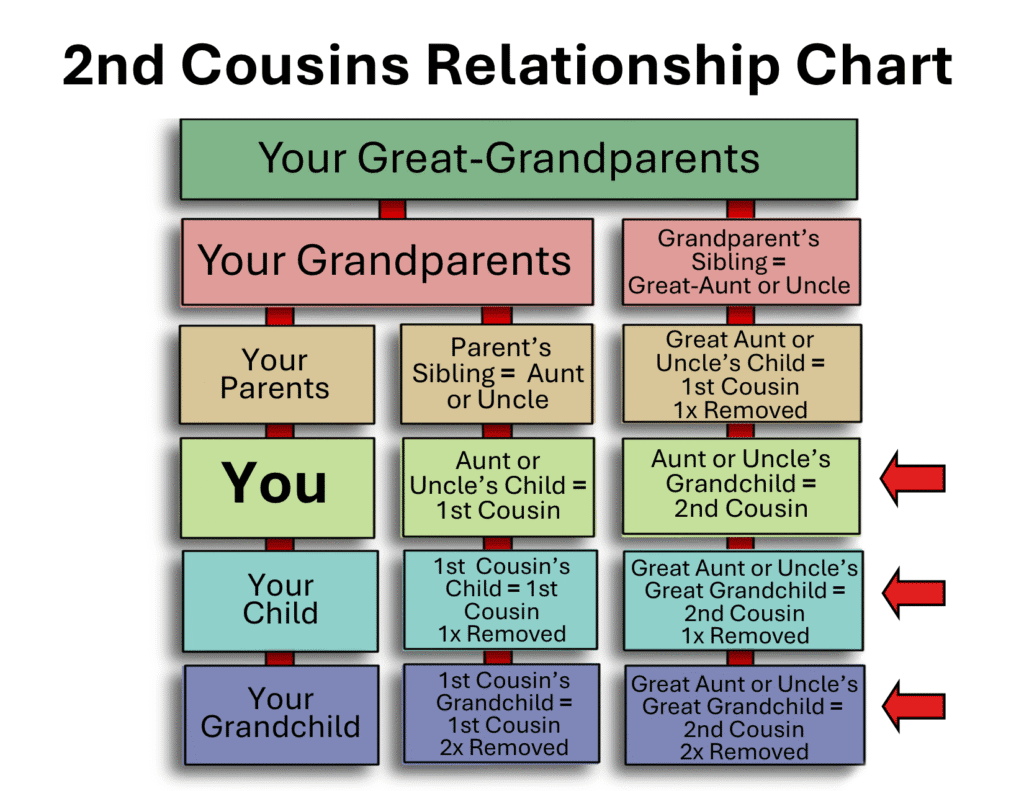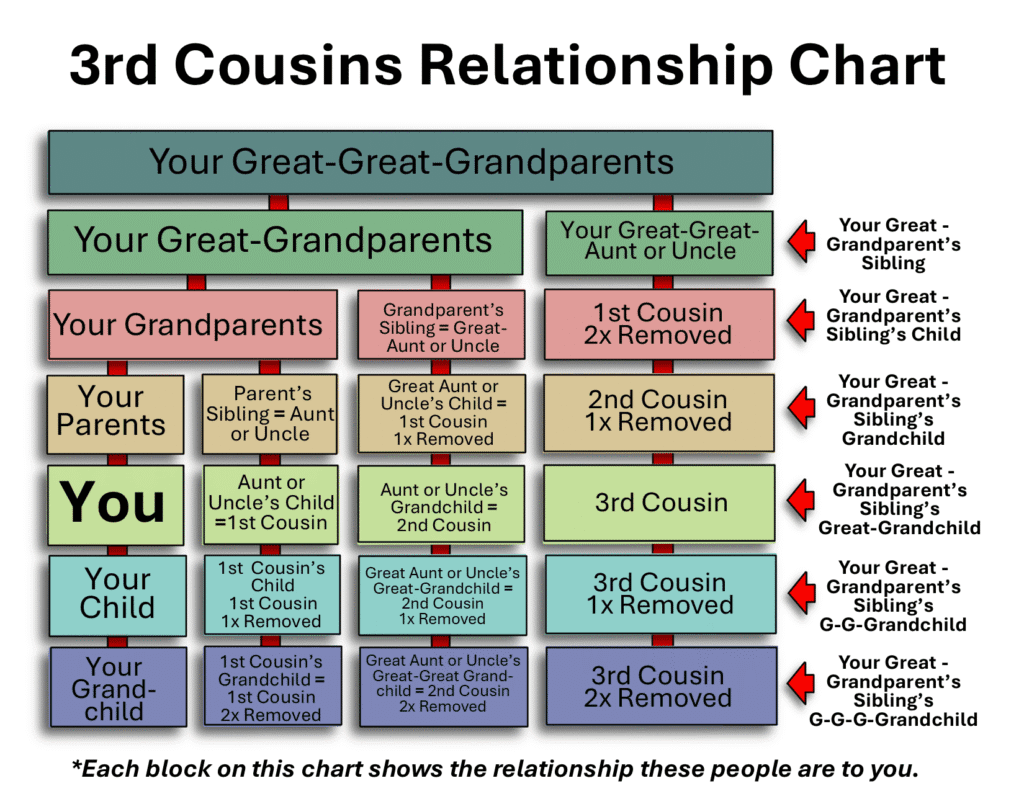My mom loved visiting family. Every few months, we’d load up the car and head “down country,” as she used to say, to the little farming town where most of our extended family lived. We’d stop for lunch at one cousin’s house, then spend the rest of the afternoon making the rounds — catching up with folks before heading back home.
I learned real quick not to ask, “How are we even related to them?” That one little question would unlock a full-on family history lesson — and as a kid, I just couldn’t keep up with all the great-aunts, once-removeds, and third cousins twice something-or-other.
Cousin relationships can be confusing — no doubt about it. Ever caught yourself wondering, “What’s my cousin’s child to my kid?” Or heard someone say, “She’s my second cousin once removed,” and just nodded like you understood? Yeah… same.
The good news? It doesn’t have to be that complicated. In this post, I’ll walk you through it all in plain English — so by the end, you’ll actually get what those cousin terms mean. Let’s make sense of this together.
What Does “Removed” Mean in Genealogy?
If your mom has a brother, his kids are your first cousins. That’s because you all share the same grandparents.
Now, the word “removed” gets used when there’s a difference in generations. For example, if your first cousin has a child, that child is your first cousin once removed. “Once removed” just means they’re one generation below you.
If your cousin has grandkids, those kids are your first cousins twice removed — two generations below you.
It works the other way too. If your great aunt or great uncle (your grandparent’s sibling) has a child, that person is your first cousin once removed too — but this time, they’re one generation above you.
Basically, “removed” just means “from a different generation.”
Curious about genealogy term meanings? Check out our post Genealogy Terms Explained.
Family Relationship Chart -1st Cousins

Who Are My 2nd, 3rd, or 4th Cousins?
Second, third, and fourth cousin relationships can get a little trickier. To figure out distant cousin connections, you need to identify which set of grandparents, great-grandparents, or great-great-grandparents you have in common.
If someone is your first cousin, you share a set of grandparents.
Second cousins share great-grandparents.
Third cousins share great-great-grandparents, and fourth cousins share great-great-great-grandparents.
For example, your children and your first cousin’s children are second cousins because they share a set of great-grandparents. Your grandchildren and your first cousin’s grandchildren are third cousins because they share a set of great-great-grandparents.
Totally confused yet? It’s okay — I didn’t get it at first either! That’s why I made this chart to help make it all easier to understand.
Family Relationship Chart -2nd Cousins

Note: I want to take a moment to clarify something about the chart above. Someone recently pointed out (very thoughtfully) that I labeled a grandparent’s sibling as a great-aunt or great-uncle. Technically, the correct term—especially in formal genealogy or when using genealogy software—is grand-aunt or grand-uncle.
That said, many people still use great-aunt and great-uncle in everyday conversation. In fact, most of us simply refer to them as “aunt” or “uncle” when talking about family. It’s a common and widely accepted way of speaking, especially in certain regions, including parts of the South.
While the formal terminology may differ slightly, I chose to reflect the way these relationships are most often described in real life.
Family Relationship Chart -3rd Cousins

Can Cousins Marry Cousins?
Most people are surprised by the idea of cousins getting married, but it’s not as rare as you might think.
My mom’s family was from the country — and I don’t just mean small-town country. I’m talking about home-cooked meals, cornfields and cotton, and houses spaced miles apart. (My mother got her driver’s license on a tractor for goodness sakes!)
Back in the day, traveling wasn’t easy, and when it came time to date or find someone to settle down with, options were limited. That’s how distant cousins sometimes ended up marrying, or how brothers from one family would marry sisters from another.
In fact, cousin marriages—especially between second cousins or more distant relatives—were historically quite common in rural and isolated communities. Even today, first cousin marriage is still legal in about half of U.S. states, and in many countries around the world, it’s not only legal but culturally accepted.
Family trees in these situations can get pretty tangled. It’s not unusual to find that you’re second cousins on one side of the family and third cousins on another — something genealogists refer to as pedigree collapse. And when two brothers marry two sisters, the children are what’s known as double cousins, because they share both sets of grandparents.
This kind of family overlap can make figuring out relationships a little tricky. But don’t worry — just take it one step and one branch at a time. It’s all part of the fun!
Enjoy the journey and Happy Searching!
FAQ
Basic Cousin Relationships
- Siblings → Share both parents
- First Cousins → Share grandparents
- (Your parent’s sibling’s child)
- Second Cousins → Share great-grandparents
- (Your grandparent’s sibling’s grandchild)
- Third Cousins → Share great-great-grandparents
- Fourth Cousins → Share 3rd great-grandparents
“Removed” Cousins
- Once Removed = 1 generation apart
(Your cousin’s child, or your parent’s cousin) - Twice Removed = 2 generations apart
(Your first cousin’s grandchild, or your grandparent’s cousin) - Three Times Removed = 3 generations apart (Your cousin’s great-grandchild)
The Legal Stuff
Please keep in mind that when you click our links and make purchases, we may receive a small commissions. This does not impact our reviews and comparisons as I try my best to keep things fair and balanced, in order to help you make the best choice for you.

